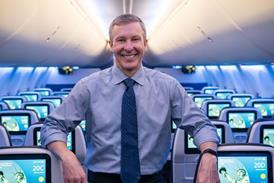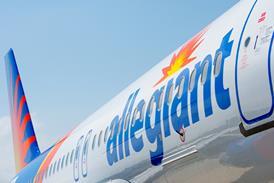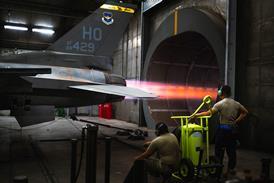Airline traffic increased among leading global carriers more than 6% in 2015 as demand remained strong in what was the industry's most profitable year to date.
While lower fuel costs have driven improved airline profitability, the lower fares that have resulted from lower costs and continued competitive pressures have also contributed by helping boost demand. This is evident in financial figures for US carriers, where despite a trebling in operating profits, US carrier revenues stayed flat in 2015.
Figures collected by Flightglobal covering nearly 70 global carriers and airline groups show passenger traffic as measured in RPKs up 6.3% in 2015. That compares to growth of 5.1% and 5.7% traffic growth for comparable carriers in 2014 and 2013 respectively.
Collective load factors were also again on the rise as the rate of traffic growth outpaced the 5.2% extra capacity these airlines added in 2015. As a result, combined load factors for these airlines stood almost a point higher at 81.3%.
AMERICAS
Passenger traffic in the Americas was 4.7% higher in 2015 than the previous year. That was in part driven by fast growth among Mexican carriers and low-cost operators in the USA.

Aeromexico and fast-growing low-cost pair Interjet and Volaris all enjoyed double-digit traffic growth in 2015, Interjet increasing traffic a quarter. Traffic growth was tempered elsewhere in Latin America, as currency and economic challenges – most notably in the key Brazilian market – took a toll. Brazil's two biggest carriers – Gol and TAM – both recorded only fractional traffic growth for the year.
US discounters Allegiant Air and Spirit Airlines grew the fastest, albeit from relatively a low base in 2015. Spirit increased traffic more than a quarter in 2015, while Allegiant grew its traffic 14%. This growth fell short of the extra capacity the two carriers added during the year, and load factor slipped more than two points at both carriers.
Both have continued on the growth path, announcing a string of routes for this year as both increasingly target mid-sized airports.
Spirit Airlines' new chief executive Bob Fornaro says the carrier does not expect to "repeat a 30% growth rate" – the speed at which the airline expanded in 2015 – again in the future. But Spirit still expects to increase capacity in the 15-20% range annually in coming years. Spirit capacity will rise about 27% in the first quarter and a fifth for the full year in 2016.
At the other end of the spectrum, the US majors kept their tight grip on capacity and passenger traffic slightly outperformed this. As a result, American Airlines Group – now fully incorporating US Airways – joined Delta Air Lines and United Airlines in increasing load factor during the year.
Overall, North American airline traffic growth stood at 4.5%, slightly ahead of the extra capacity and helping lift collective load factors fractionally to 83.7%.
EUROPE
Passenger traffic among leading European carriers increased just over 5% in 2015 compared with the previous year. Again, this reflects relatively moderate growth at Europe's biggest carriers. British Airways, Lufthansa and Air France-KLM Group all kept capacity increases down to not much more than 2%. Traffic at all three outpaced this slightly, resulting in small increases in load factors for the year.

But a number of network carriers, including Lufthansa unit Brussels Airlines and BA's IAG stablemate Iberia grew traffic sharply over the year.
The Spanish carrier increased traffic almost 14% in 2015, rebuilding much of the network it cut during its restructuring two years ago – passenger traffic had fallen nearly 17% in 2013. That return to growth continues this year, not just with the restoration of routes to Johannesburg and San Juan this summer, but also the Oneworld carrier's first Asian services to Tokyo Narita and Shanghai.
Brussels Airlines, which faced increased pressure at its home base from the arrival of low-cost carriers Ryanair and Vueling in the autumn of 2014, continued its recent expansion with a second consecutive year of double-digit passenger traffic growth. This outpaced the extra capacity added to the network, helping it lift load factor more than two points.
"Our broad network and new commercial strategy are becoming more popular by the day. In the light of today's fierce competition in the airline industry, we are very pleased with this result," says Brussels Airlines chief executive Bernard Gustin. The airline points to a 13% increase in passengers on European flights and almost 10% rise on its African flights, where markets have recovered as the devastating Ebola outbreak was gradually controlled.
The improvement comes despite the temporary slowdown in demand in December resulting from security concerns in Brussels in the immediate aftermath of the Paris terror attacks.
Aeroflot reports both mainline and group traffic were up in 2015, rising 10.4% and 8.4% respectively. But there was a big difference in the balance between international and domestic sectors between Aeroflot's mainline operation and the wider group, which also includes low-cost arm Pobeda and the Transaero flights it took on following the latter's collapse in the autumn.
International traffic growth remained strong at Aeroflot's mainline operations, rising 10% in 2015. While it says the suspension of flights to Ukraine and Egypt impacted international traffic performance, Aeroflot notes its performance on international routes was "supported by a continued decline in competition" as several foreign carriers reduced flight frequencies to Russia, as well as by increased international transit traffic through Moscow Sheremetyevo airport.
But Aeroflot's group traffic shifted more towards domestic traffic as leisure travel demand in particular switched as the sharp fall in the Russian currency made international travel more expensive. Aeroflot group international traffic was down 4% at a group level. By contrast, group domestic traffic was up more than a quarter. That includes Pobeda. which carried more than three million passenger in 2015. That latter has now just begun its first international services.
Europe's low-cost carriers continued their relentless expansion during the year. Norwegian and Vueling both recorded double-digit rises in traffic, while EasyJet, Ryanair and Wizz Air grew passenger numbers 6.8%, 17.5% and 22% respectively in 2015.
ASIA-PACIFIC
Passenger traffic among leading Asia-Pacific carriers grew at the fastest rate of the three biggest regions, increasing just short of 9% in 2015. As this growth outpaced the additional 6% of capacity, carriers in the region enjoyed the biggest improvement in passenger load factors for the year. Collective Asia-Pacific load factor increased almost two points to 79.2%. However, it remains the only one of the three big regions to average load factors under 80% among its leading carriers.

Despite the wider turmoil in Chinese financial markets, the country's carriers continue to enjoy strong fortunes. Air China, China Eastern, China Southern and Hainan Airlines all increased passenger traffic by double-digits in 2015 – increases in line or above the capacity they added during the year.
Speaking at a briefing in January, after more falls in the Chinese markets at the start of the year, IATA chief economist Brian Pearce reasserted confidence in the Chinese airline market. "Air travel is expanding as the Chinese get richer and we see more services being added. And we are still seeing growth and China expanding at double-figure rate," he says. "So we are not concerned about falls in the stock market. Clearly, there has been some weakening in the economy, but you are still seeing robust growth."
This is echoed by AAPA director general Andrew Herdman. "We have to be very careful we don't misunderstand," he says, noting that many of China's challenges relate to the capital economy. "Parts of the Chinese economy are doing just fine – it's a step change from an export-led and capital infrastructure economy to balancing into a more demand-led economy. Consumer sentiment is still on the up."
Further market concerns were sparked when China in January revealed that its economic growth slipped to 6.9% in 2015 – its lowest level in 25 years. But this growth still outpaces global GDP levels ,and Herdman notes that lower growth rates come off what is now a much larger economy. "The Chinese economy is three times the size it was 10 or 12 years ago – so 7% of this is a lot," he says.
Elsewhere in Asia-Pacific, a number of carriers which have endured difficult times reported a stronger 2015. Thai Airways, for example, increased passenger load factor more than four points as it grew traffic almost 5% despite cutting capacity. India's Jet Airways, now an Etihad equity alliance partner, reported passenger traffic up almost a fifth in 2015 and load factors more than three points higher.
Restructuring Malaysia Airlines remains a work in progress. For the 12 months to September 2015, passenger traffic for the airline – which has embarked on a turnaround strategy – is running around 9% down on the same period in 2014/15.
Source: Cirium Dashboard























